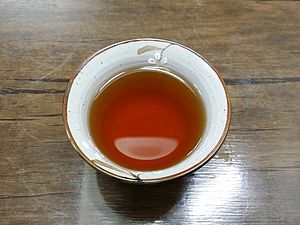Sicklepod tea facts for kids
 |
|
| Type | Tea |
|---|---|
| Country of origin | Korea |
| Ingredients | Sicklepod seeds |
| Korean name | |
| Hangul |
결명자차
|
|---|---|
| Hanja |
決明子茶
|
| Revised Romanization | gyeolmyeongja-cha |
| McCune–Reischauer | kyŏlmyŏngja-ch'a |
| IPA | [kjʌl.mjʌŋ.dʑa.tɕʰa] |
Gyeolmyeongja-cha (결명자차; 決明子茶), also known as sicklepod tea, is a popular tea from Korea. It's made from the roasted seeds of a plant called Senna. People drink it for its taste and because it's believed to be good for you.
Contents
What is Gyeolmyeongja-cha?
This special tea is made from the seeds of Senna plants. These plants used to be called Cassia. The specific types of plants used are usually S. obtusifolia and S. tora. The seeds are roasted, but not ground into a powder, before being used to make the tea.
The Main Ingredient: Sicklepod Seeds
The roasted seeds are called gyeolmyeongja (결명자; 決明子) in Korean. These seeds come from the Senna group of plants. These plants are part of the legume family, which includes beans and peas.
Some people also use seeds from a plant related to Cassia nomame, which is now known as Chamaecrista nomame.
How to Make Gyeolmyeongja-cha
Making this tea is quite simple. First, you take about 20 to 30 grams of dried sicklepod seeds. Then, you roast them until they are ready. After roasting, you boil the seeds in about 600 milliliters of water. The tea is usually enjoyed plain, without adding any sugar or honey.
Uses and Benefits
The name gyeolmyeongja has a special meaning. It means "the seed that brightens the eyes." Because of this, Gyeolmyeongja-cha is often thought to be good for your eyesight. It is also used in herbal medicine in Korea. People believe it can help with different health issues.
Similar Teas Around the World
Sicklepod tea is not just popular in Korea. People in other parts of Asia also drink similar teas.
Teas in Japan
In Japan, there's a tea called habu-cha. Originally, this tea was made from roasted seeds of habusō, or S. occidentalis. However, most habu-cha sold today is made from S. obtusifolia, similar to the Korean tea.
Another plant, Chamaecrista nomame, is called kawara-ketsumei in Japan. This means 'riverbank sicklepod'. Its leaves and seeds are used to make hot drinks like mame-cha or hama-cha. These are especially popular in southern Japan, like the Kyushu region.
Teas in Southeast Asia
Cassia seed tea is also enjoyed in Southeast Asia, including countries like Thailand. In Thailand, Senna tora is known as chum het thai. The roasted seeds are used to help the body get rid of extra water. The seeds or leaves can also be used to help with digestion and keep things moving smoothly.
Coffee Substitutes
Interestingly, roasted and ground Cassia tora seeds have been used as a coffee substitute in India. Also, Cassia occidentalis was brewed into a drink once called "negro coffee" in Africa, South America, and the West Indies. The leaves of these plants have also been used as a coffee substitute, even though they don't have much flavor.

